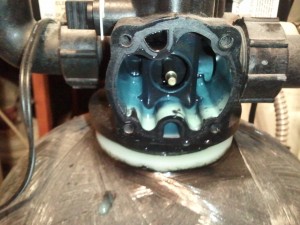A Utah soft water service technician sent me this photo:
 The photo shows the rear view of an Erie 541-based water softener with its solenoid back-cap removed. The flow path of this control valve is such that the backwash port is at the bottom, and soft water flows through the top port for time brine refill.
The photo shows the rear view of an Erie 541-based water softener with its solenoid back-cap removed. The flow path of this control valve is such that the backwash port is at the bottom, and soft water flows through the top port for time brine refill.
The softener is 5 years old and the homeowner had been neglecting to add an appropriate resin cleaner to his brine tank. It is evident that there are low levels of copper in his influent water supply. The low levels of copper have been accumulated within the softening resin and then discharged as a concentrate during the regeneration process. The milky blue color in this picture is from copper sulfate which formed as a precipitate during the regeneration process.
Copper can come from a variety of sources, not just from the city supply. This particular city’s Consumer Confidence Report indicates negligible levels of copper at the distribution plant, so evidently the elevated copper is a localized issue, most likely related to corrosion. Ionic copper levels can increase due to localized corrosion from dissolved CO2 gas, electrolysis, and even microbially induced corrosion.
Water softeners are primarily designed to remove calcium and magnesium ions from water. All cation resins are attracted to metallic ions, but very few resins are able to release them properly and uniformly during a regeneration.
Modern resin cleaners like ProGuard assist the resin in purging metallic ions from it’s structured matrix. As a side benefit, ProGuard will clean the resin more effectively and hold the metals in suspension through the use of EDTA, an effective chelating agent.
By not using an effective resin cleaner like ProGuard, the softening resin was unable to effective purge heavy metals from its matrix. Metallic fouling will cause a decrease in the overall effective capacity of the resin. This capacity decrease results in the softener being unable to maintain a continuous supply of soft water.
The homeowner noticed evidence of hard water bleed-through with hard water spotting, poor laundry results, and soap scum. Being enterprising, he adjusted the capacity setting on his softener which of course caused to clean more frequently and use more salt to clean itself. This was a temporary solution to the symptoms, but did not actually address the underlying problem.
High concentrations of salt brine can induce osmotic shock to resin and accelerate natural attrition. Accelerated attrition induces premature physical failure and the resin will begin to crack and fracture. Cracking and fracturing result in a net pressure drop across the resin bed which diminishes the systems overall ability to properly clean itself and causes a greater deltaP (Pressure differential) during service.
The solution to this problem was a complete cleaning and disinfection as well as augmenting with resin designed specifically to accommodate metallic ions in water with a minimum of physical attrition.
One Reply to “Copper fouling in a water softener in Utah”